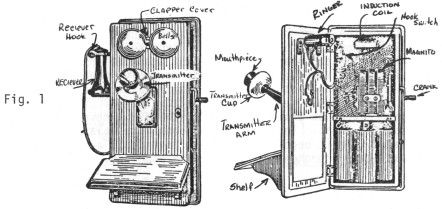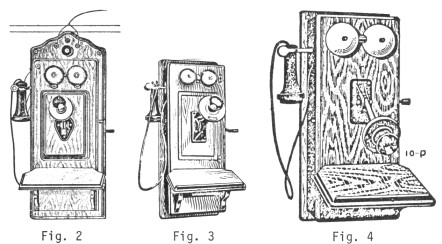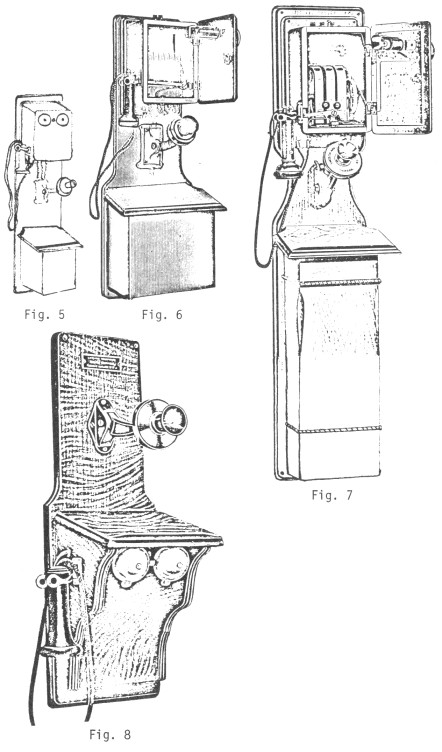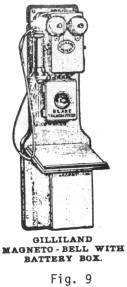The Telephone's First 100 Years
by Larry Harmon
Reprinted from "INSULATORS - Crown Jewels of the Wire", December 1978, page 3
The advancement of communications during the middle to late 1800's enabled
this country to enjoy the finest communication system in the world.
Rapid
changes in the technology caused many companies to rise and fall. In their past
were left unusual contraptions, which years later became highly desirable by
collectors like myself. Many are indeed antique, but all are examples of how
free enterprise created such a strong nation.
Being involved in telephony through
employment, my interest in old phones, as well as historical facts, set a
spark within me to collect wooden wall phones.
As a collector, I am continually
approached and asked: "What do I have?" "What is its age?"
"What is it worth?" I do not consider myself a professor on the
subject, but do have some information I would like to share. I would appreciate
any bonafide facts that could be added.
Components of the Telephone

Most individuals do not know the parts of a telephone; and if a part is
needed, they don't know what to ask for. Again, due to the wide variety of
styles, only the basic parts and designs will be covered. Figure 1 shows the
parts most generally found inside, and on the telephone.
Single Box Telephones
The single box telephone was introduced in the very
early 1900's and manufactured up through 1935. Any sets after 1935 usually were
refurbished or remanufactured. The single box phones were made in various
styles, but classed in three groups by collectors. The first group is known as
C.T.P.F.F. (Cathedral Top Picture Frame Front). As shown in figure 2 on the
following page, the top of the backboard is decoratively cut in a cathedral
form. The door has a groove cut in it surrounding the transmitter arm. These
phones were made about 1900-1912.

Figure 3 displays the P.F.F. (Picture Frame Front). The difference is,
compared to Fig. 2, the absence of the cathedral top. These sets were generally
made from 1904-1920.
Figure 4 shows the P.F. (Plain Front) This set is without
decoration and was in manufacture from about 1907-1935. These are the least
collectable of all wooden sets. On occasion phones are brought in for repair or
appraisal with wire banded headsets, or the common monophone receiver on the
side. Many phones were converted to the monophone receiver in later years to
eliminate the troublesome front mount transmitters and bipolar side mount
receivers. Railroads commonly converted their sets to the headband receiver, and
in many cases removed the magneto as they converted to common-battery power. The
caller would get central to answer by pushing the front mount call button on the
phone. These railroad phones are relatively low in demand, since it becomes too
costly to install a magneto, shelf and other components to render the phone
desirable.
Two Box Phones
A two box phone gets its name from its appearance. The
components of the phone are arranged on a board called the backboard. The two
boxes, the top box or ringer box, and the bottom box or battery box, are placed
at each end of the backboard. Between the two boxes is situated the transmitter
arm. Most all these arms are made of cast iron, and are quite bulky. Very few of
these arms were pressed steel. Before buying, check carefully, as you may be
getting a cobbled up set. The cast iron arm is used to house the induction coil.
The two box phones were made from around 1891-1905. The most common of these
type sets were Stromberg-Carlson Mfg. Co. Chicago-Rochester, and are least
desirable to collectors. There are three basic styles of two box phones. Figure
5 shows the straight sided backboard; figure 6 displays the shouldered sided
backboard; and figure 7 is of the tandem. The tandem is noted by the length of
the phone itself. They are usually over 39" in length. The name Tandem refers to
the battery box. The batteries are stacked on top of each other on brackets.
These are quite desirable by collectors.

Large Image (220 Kb)
Fiddle Back Phones
Figure 8 illustrates a phone that, when lying down,
resembles a fiddle. These sets are also a good collectors item. They were very
popular during the transition from two box phones to the later single box sets.
They were made from about 1894-1910.
Three Box Phones
The highlight of most collectors is to acquire a three box phone. Figure 9 shows a '3 Boxer" with the (a) top box, (b) transmitter box, and (c)
battery box. These phones are next to worthless if modified or altered in any
noticeable way. The scarcity of replacement pieces to place the phone back to
its original state restricts interest and price immensely. In comparison, a
complete 3 box phone will bring a tidy sum if complete and original. It is very
hard to fool a serious collector with replacement or new parts.

Telephone collecting is a fascinating hobby, and has a national organization
where much information can be found. If I haven't learned anything else, the one
thing I have learned is never to drill new holes in phones, as many collectors
will pay much more for a phone minus a piece or two, rather than one cobbled up.
Single box phones will not bring fantastic prices from collectors, as they are
still too common. Three box and fiddleback phones are the most sought after.
Also unusual carved, shaped, or very primitive phones are the best. If at all
possible, I will try to assemble for future reading a list of parts and
descriptions of rarer phones demanded by collectors.
| 